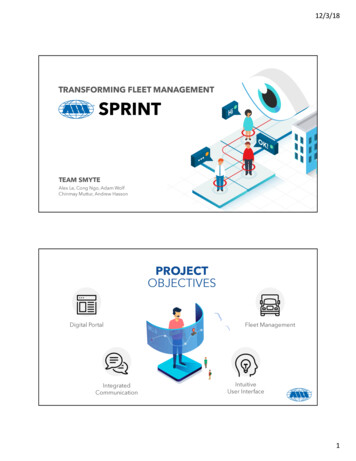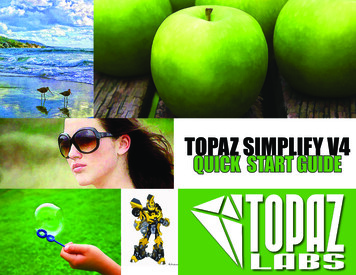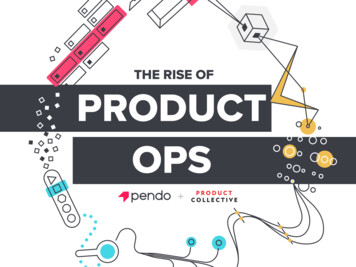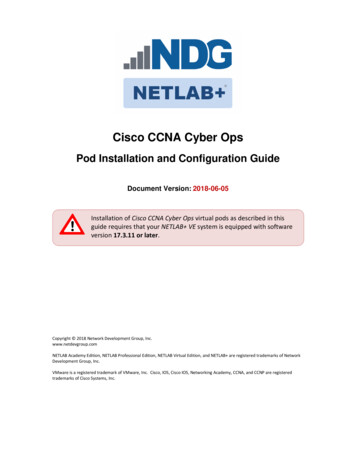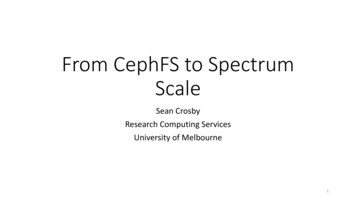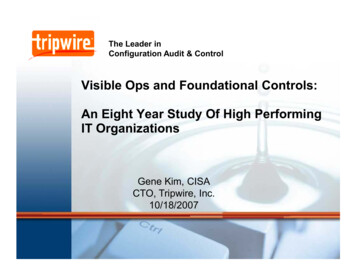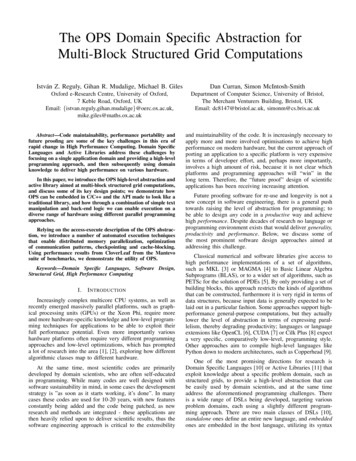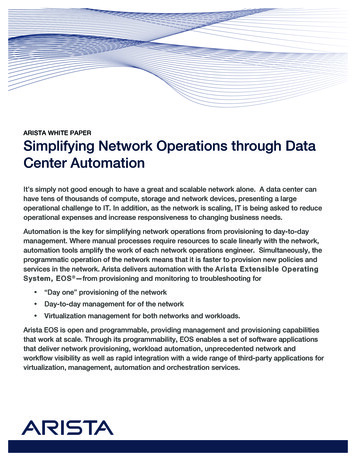
Transcription
ARISTA WHITE PAPERSimplifying Network Operations through DataCenter AutomationIt’s simply not good enough to have a great and scalable network alone. A data center canhave tens of thousands of compute, storage and network devices, presenting a largeoperational challenge to IT. In addition, as the network is scaling, IT is being asked to reduceoperational expenses and increase responsiveness to changing business needs.Automation is the key for simplifying network operations from provisioning to day-to-daymanagement. Where manual processes require resources to scale linearly with the network,automation tools amplify the work of each network operations engineer. Simultaneously, theprogrammatic operation of the network means that it is faster to provision new policies andservices in the network. Arista delivers automation with the Aris ta Extensible OperatingSystem, EOS —from provisioning and monitoring to troubleshooting for “Day one” provisioning of the network Day-to-day management for of the network Virtualization management for both networks and workloads.Arista EOS is open and programmable, providing management and provisioning capabilitiesthat work at scale. Through its programmability, EOS enables a set of software applicationsthat deliver network provisioning, workload automation, unprecedented network andworkflow visibility as well as rapid integration with a wide range of third-party applications forvirtualization, management, automation and orchestration services.
There is a growing need for a fundamental change tothe provisioning of networks just like serverprovisioning has evolved over the years by leveragingautomation tools such as Puppet and Chef. Thedemand for agility and deployment at scale withregards to provisioning and network operationsrequires a new level of automation and integration withcurrent data center infrastructure. The underlyingdesign of the network operating system provides thearchitectural foundation to meet these requirements.ARISTA EOS: FOUNDATION FORPROGRAMMABILITY ANDAUTOMATIONArista EOS is the industry’s most advanced, open andextensible network operating system. EOS combinesmodern-day software and operating system (O/S)concepts including transparently restartableprocesses, open platform development, an unmodifiedLinux kernel, and a stateful, programmablepublish/subscribe database model for switching state.The Arista EOS software framework guaranteesconsistent operations, workflow automation and highavailability.Key advantages of using an unmodified Linux kernelinclude the following: Retaining benefits from Linux communitydevelopment including bug fixes, featureupdates and security updates Full Linux capabilities such as using standardtools right out of the box, installing additionaltools through RPM packages, running thirdparty Linux applications, and creating customtools with bash, perl and python. The ability to use the same Linux-basedtoolsets to manage network nodes as for serverand compute nodes.Arista EOS has a unique multi-process, state-sharingarchitecture that separates state information andpacket forwarding from protocol processing andapplication logic. This modular architecture enablesstateful fault isolation, stateful fault repair, securityexploit containment as well as in-service softwareupdates.Arista EOS offers the following features that supportautomation: Modular, state-sharing architecture that enablesstateful fault isolation and fault repair Single binary EOS image that can be deployedacross any family of products. This improvesthe testing depth on each platform, reducestime-to-deployment, and keeps features andbug resolution compatibility across allplatforms. Programmable at all layers: Linux kernel,hardware forwarding tables, virtual machineorchestration, switch configuration, provisioningautomation, and advanced monitoring Open Linux and EOS access with the flexibilityand choice to provide authorized and secureaccess through TACACS & RADIUS AAAfeaturesFigure 1: Arista EOS ArchitectureARISTA WHITE PAPERSIMPLIFYING NETWORK OPERATIONS 2
PROVISION A “DAY ONE” NETWORKScaling provisioning as the network grows is a challenge. Often manual configuration is used to provision thenetwork. However, as the network grows, an increasing number of individuals are involved, and often in thecoordination and communication of the process, errors get introduced. Simultaneously, businesses are morereliant than ever on data and services being delivered from their data center; data center outages have even aneven larger impact today. Automation of initial and ongoing provisioning and network monitoring are keystrategies for reducing the human error component.ARISTA ZERO TOUCH PROVISIONING (ZTP)A first step in automating the data center is the ability to provision an existing or new green field network quicklyand programmatically. Arista EOS Zero Touch Provisioning (ZTP) automates the configuration of a new orreplacement switch without user intervention or requiring a network engineer with a serial console cable.With ZTP, a switch loads its image and configuration from a centralized location within the network. Usingstandards based protocols (e.g. DHCP, T/FTP, HTTP), the network can be rapidly provisioned. Administrators canprogrammatically tailor boot configurations based on a variety of parameters, meeting the needs of even the mostcomplex data center deployments.DHCP ServerBoot Config ServervSphereZTP/ZTRFigure 2: Zero Touch Provisioning for a new or replacement switchZTP automates the deployment of network switches such that it is simply a case of racking the switches, cablingthem and powering them on. ZTP eliminates manual configuration for provisioning changes and operating systemupgrades. Combined with other Arista solutions, like Arista EOS VM Tracer, automatic VLAN configuration, datacenter managers can fully automate the bring-up of network elements and virtual servers.Operational MeasuresTime-to-ProvisionEngineering Resources% ErrorsManualAutomated with ZTP2 to 3 days15 minutes2 to 3 engineers1 engineer10 to 20%0%Table 1: Operational savings moving from manual to automated, ZTP-based provisioning for 10K ports.ARISTA WHITE PAPERSIMPLIFYING NETWORK OPERATIONS 3
With ZTP, a single engineer can program the configuration updates. With manual configuration, several networkengineers are required to roll-out the changes within an acceptable time frame, with each manual change creatingan opportunity for introducing error. Automated provisioning reduces the need for people resources as well as thetime to deploy the change and likelihood of mistakes.ARISTA ZERO TOUCH REPLACEMENT (ZTR)An extension to ZTP, Zero Touch Replacement (ZTR) enables switches to be physically replaced, with thereplacement switch picking up the same image and configuration as the switch it replaced. Switch identity andconfiguration are not tied to switch MAC address but instead are tied to location in the network where the deviceis attached, using on LLDP information from neighboring devices. ZTR reduces time-to-restoration of service tothe time it takes to rack a new switch, cable it and power it on, without any dependency of a network engineer’savailability to physically attach a serial console cable and configure the switch.AUTOMATE DAILY OPERATIONSOngoing management of the data center network is the second area to focus on automating. With hundreds andthousands of compute, storage and network elements requiring maintenance and support, automation is the keyto reducing ongoing operating expenses while enabling changes to be made quickly.Arista EOS integrates with popular Linux-based tools for configuration and monitoring. Arista EOS has built-intracer tools for monitoring and troubleshooting all aspects of the network, showing key linkages to the applicationlayers. Arista EOS offers an API to the full CLI, Arista eAPI, that can be used to create custom tools and scripts.Lastly, the Smart System Upgrade (SSU) feature automates switch configuration and software update.ARISTA EOS DEVOPS INTEGRATION: CONSISTENT TOOLSETS FOR COMPUTE AND NETWORKELEMENTSOften the modern data center infrastructure compute component has been provisioned and managed by DevOpstools like Puppet and Chef. Data center IT want to simplify their operations by using the same Linux-basedtoolsets to manage both network and compute and storage elements. With its unmodified Linux kernel, AristaEOS integrates with the rich ecosystem of Linux DevOps tools for management and workflow orchestration,including Puppet, Chef, Ansible, Splunk, Nagios and Ganglia.Figure 3: Automation with Puppet and EOSARISTA WHITE PAPERSIMPLIFYING NETWORK OPERATIONS 4
Traditionally, one would have to wait on a change ticket for a network administrator to add a VLAN at the Top-ofRack (TOR) until a new server is provisioned. With EOS’ DevOps integration, one combined network-serveradministrator can now use Puppet to make configuration changes on the network devices at the same time whilea server is being provisioned.MONITORING AND TROUBLESHOOTING AUTOMATION: ARISTA EOS NETWORK TRACERSArista EOS tracer tools provide a new model for faster troubleshooting from fault detection to fault isolation. Thetracers provide critical, real-time information from the network to the application to network operations. Thetracers enable the network system to: Proactively detect network issues Automatically react to coordinated actions or take direction from other applications/infrastructures Notify other elements or operations teams of changing conditions.HealthPathVirtual MachineMap ReduceComplete chassishealth checksActive fault detectionHop-by-hop statisticsVirtual visibilityDynamic provisioningTrack nodesMonitor statisticsPhysicalEnd-to-end VisibilityApplicationFigure 4: Arista EOS – Network TracersArista EOS provides network tracers for end-to-end visibility:Health Tracer – This is a suite of EOS agents, which automatically and continuously monitor the health of theswitch. Each agent proactively monitors the health status of each field replacement unit (e.g. fan, power,supervisor, etc.) and automatically takes corrective action and sends out appropriate alerts to ensure overallsystem visibility.Path Tracer – This is a protocol independent network monitoring and analysis tool that continuously and activelyprobes the network for packets that are lost, disordered or duplicated. Using this feature, proactive alerts cansend notifications to network operations, initiate the execution of remedial scripts or even notify externalcontrollers.VM Tracer – As virtualized data centers have grown in size, the physical and virtual networks that support themhave also grown in size and complexity. Virtual machines connect through virtual switches and then to thephysical infrastructure, adding a layer of abstraction and complexity. Server side tools have emerged to helpVMware administrators manage virtual machines and networks, however, equivalent tools to help the networkadministrator resolve conflicts between physical and virtual networks have until now not been available.Arista VM Tracer provides this bridge by automatically discovering which physical servers are virtualized and theirassociated VLANs, through VMware vCenter APIs, and then automatically applying physical switch portconfigurations in real time with vMotion events. This results in automated port configuration and VLAN databaseARISTA WHITE PAPERSIMPLIFYING NETWORK OPERATIONS 5
membership and the dynamic adding/removing VLANs from trunk ports. VM Tracer extends to VXLANarchitectures.Map Reduce Tracer – The Map Reduce tracer tracks Hadoop nodes and collects their activity statistics. The goalis to correlate congestion events with jobs running on the servers. The end result is to automatically trigger packetcapture and proactively notify on a failed Hadoop node.ARISTA eAPILANZ Tracer BRIEF– Arista Latency Analyzer (LANZ) enables tracking of network congestion in real time beforeSOLUTIONcongestion causes performance issues. Today’s systems often detect congestion when someone complains, “Thenetwork seems slow.” The INTRODUCTIONnetwork team gets a trouble ticket, and upon inspection can see packet loss on criticalAristaEOS offers availablemultiple programmableinterfacesfor applications.interfacesinterfaces. The best solutionhistoricallyto the networkteamhas been Theseto mirrorthe problematic port to acan be leveraged by applications running on the switch, or external to EOS. cationsandscriptstohavecompletepacket capture device and hope the congestion problem repeats itself.programmatic control over EOS, with a stable and easy to use syntax. Once the API isenabled, the switch accepts commands using Arista’s CLI syntax, and responds withoutput and errorsserialized capabilityin JSON, servedoverHTTP. administratorsproactivemachine-readablecongestion detectionand alertingbothhumanNow, with LANZ’sintegrated applications can:The EOS API has three major advantages:1Comprehensiveness. With Arista’s eAPI, customers can access any state and configure any properties on the switch that they could otherwise do over the CLI.Preempt network conditionsthat induce latency or packet loss third partyJSONmeans thateAPI is language agnostic and can be easilyAdapt application behaviorbasedonclientsprevailingconditions interactive documentation for the API and return values makes writing new programsIsolate potential bottlenecksearly, enabling proactive capacity planningsimple. (To view, enable the API and visit “http:// your-switch’s-ip-address / Maintain forensic data for post-process correlation and back testing2andEase-of-use and flexibility. The simplicity of this protocol and the availability ofintegrated into any existing infrastructure and workflows. Additionally, on-box,explorer.html” in a web browser).3Stability. Arista ensures that a command’s structured output will remain compatiblefor multiple future versions of EOS. This allows end users to confidently r(EAPI)ability to upgrade to newer EOSCUSTOM TOOLS THROUGHARISTAEOSEXTERNALAPIreleases and access new features. Furthermore, this affords scripts the abilityArista EOS programmatic interfaceeAPIallowsapplicationsandscriptsto havecompleteprogrammaticto operatecleanlyin datacentersrunningmultipleversionsof EOS,withoutcompromising eAPI’s simplicity.controlover EOS, with a stable and easy to use syntax. Once the API is enabled, the switch accepts commands usingArista CLI syntax and responds with machine-readable output and errors serialized in JSON, served over HTTP.EOS ARCHITECTURE OVERVIEWThe eAPI architecture is very straightforward, as diagrammed below:EOSJSONRequestCommandAPI ProcessHTTPServerClient ScriptJSONResponseJSON-RPCRequestHandlerCommand SHSessionCLITerminalCLISessionModel — ator1 of 3Figure 5: EOS eAPI – Network Automation & ProgrammabilityEOS API (eAPI)The EOS eAPI has three major advantages: Comprehensiveness: Arista eAPI gives access to the state and the ability to configure any property on theswitch that is accessible with the CLI. Ease-of-use and flexibility: The simplicity of this protocol and the availability of third party JSON clientsmeans that eAPI is language agnostic and can be easily integrated into any existing infrastructure andworkflows. Additionally, on-box, interactive documentation for the API and return values makes writing newprograms simple.ARISTA WHITE PAPERSIMPLIFYING NETWORK OPERATIONS 6
Stability: Arista maintains API compatibility across multiple EOS versions. This allows end users toconfidently develop critical applications without compromising their ability to upgrade to newer EOSreleases and access new features or run in data centers with multiple versions with multiple versions of EOS.NETWORK UPGRADE AUTOMATION WITH SMART SYSTEM UPGRADE (SSU)Deploying and taking advantage of new technology is top of mind for most organizations. Balancing the businessbenefits of adopting a rapid pace of innovation with the associated risks is a constant struggle. A major inhibitorto technology adoption is the ability to transparently insert new technologies into existing facilities withoutadversely impacting critical applications. Smart System Upgrade (SSU) is a network application designed toaddress data center network maintenance—software upgrades and configuration changes—with minimal servicedisruption.Pre-upgradeGraceful RemovalSeamless InsertionLeafSpineFigure 6: Arista Spine/Leaf SSU – Hitless UpgradeThe intent of SSU is to allow maintenance to be performed on any infrastructure element, without adverselyimpacting application traffic flow. Combining native Arista EOS functionality and direct integration with otherapplications and infrastructure components, SSU allows a network element to be transparently removed oradded.Designed to be a complete solution for data center infrastructure maintenance, Arista’s SSU provides thefollowing key benefits: Intelligent insertion and removal of network elements Programmatic upgrade to new software releases without causing systemic outages Open integration with all application and infrastructure elementsData center operations teams need more intelligent tools and extensible feature sets to manage today’s “alwayson” data center infrastructures. Arista EOS provides the foundation for innovation, driving down operational costwhile simultaneously increasing operating uptime.AUTOMATION FOR NETWORK VIRTUALIZATIONIn addition to automated day-to-day management and monitoring, some companies are automating the entireworkflow process for dynamic placement of workloads with end-to-end network virtualization. Arista EOS openarchitecture integrates with any virtualization and orchestration system, including VMware NSX, OpenStackARISTA WHITE PAPERSIMPLIFYING NETWORK OPERATIONS 7
Neutron and Microsoft SVCMM. With Arista EOS-based virtualization, workloads can be portable while preservingtheir addressing and policies, simplifying scale-out and workload placement within the data center.Arista EOS provides automated provisioning and visibility into both virtual and physical cloud network throughopen controller integration and hardware based VXLAN support on Arista platforms. Provisioning andorchestration with Arista EOS works with any native hypervisor and uniquely solves the challenge of integratingwith workflows with functionalities like DANZ for real-time congestion management, VM Tracer to expose virtualand physical connectivity, leveraging sFlow to get traffic statistics for the VXLAN overlay. Monitoring and visibilityinto these workflows play a pivotal role in simplifying cloud network automation and operations.VIRTUALIZATIONMONITORINGFigure 7: Arista Network Application - OpenWorkloadBenefits of workload mobility with Arista EOS include Seamless Scaling – full support for network virtualization, connecting to major Software Defined Networking(SDN) controllers Integrated Orchestration – interfaces to VMware, OpenStack, Plumgrid for provisioning Workflow Visibility – visibility to the VM-level with VM Tracer, enabling portable policies, persistentmonitoring, and rapid troubleshooting of cloud networks. Combined Infrastructure and Application Visibility—Data about network state, including underlay andoverlay network statistics can be sent to third party monitoring applications such as Splunk, ExtraHop, Corviland Riverbed. With critical infrastructure information exposed to the application layer, issues can beproactively avoided.ARISTA WHITE PAPERSIMPLIFYING NETWORK OPERATIONS 8
SUMMARYShifting spending from IT Operations to innovation and increased responsiveness to changing business needs arethe key goals for every CIO. The only way for Enterprises and Service Providers to obtain substantial operationalcosts reduction is to automate their network environments. Traditionally enterprises have been shackled inworking with closed or hybrid open network operating systems with little to no capabilities for automatingprovisioning and day-to-day operations. Arista EOS changes the equation.Arista EOS is truly an open, programmable, next generation network operating system. With Arista EOS, a datacenter can be fully automated for provisioning and for managing ongoing changes and troubleshooting day-to-dayissues. Through automation, IT can achieve operational savings while increasing its agility, even as the networkscales.ARISTA WHITE PAPERSIMPLIFYING NETWORK OPERATIONS 9
Santa Clara—Corporate Headquarters5453 Great America ParkwaySanta Clara, CA 95054Tel: 408-547-5500www.arista.comIreland—International Headquarters4130 Atlantic AvenueWestpark Business CampusShannonCo. Clare, IrelandSingapore—APAC Administrative Office9 Temasek Boulevard#29-01, Suntec Tower TwoSingapore 038989Copyright 2014 Arista Networks, Inc. All rights reserved. CloudVision, and EOS areregistered trademarks and Arista Networks is a trademark of Arista Networks, Inc. All othercompany names are trademarks of their respective holders. Information in this document issubject to change without notice. Certain features may not yet be available. Arista Networks,Inc. assumes no responsibility for any errors that may appear in this document.08/14ARISTA WHITE PAPERSIMPLIFYING NETWORK OPERATIONS 10
ARISTA WHITE PAPER SIMPLIFYING NETWORK OPERATIONS 6 membership and the dynamic adding/removing VLANs from trunk ports. VM Tracer extends to VXLAN architectures. Map Reduce Tracer - The Map Reduce tracer tracks Hadoop nodes and collects their activity statistics. The goal is to correlate congestion events with jobs running on the servers. The .
